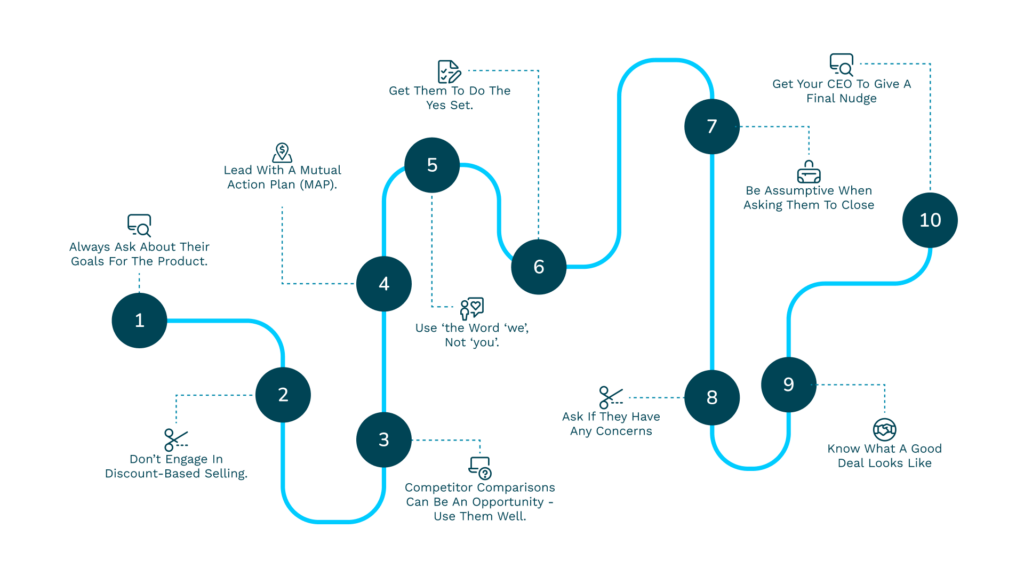“How hard can you push a client to close a deal?”
Sales leaders get asked this question a lot.
“Why push at all?” some might answer.
If you have clarified the value they’ll get out of your product, they would want to sign up.
But you have to be tactical about it. Sometimes customers don’t want to commit until next week, next quarter, and so on.
And that’s where sales closing techniques come in.
Know better to sell better! Check how Nektar helps you take control of your sales funnel.
What are Sales Closing Techniques and Why Do They Matter in B2B?
For the best sales reps, selling is an exact science. They use tried and tested strategies to:
- Understand what makes people buy
- Appeal to those factors to close sales
The strategies are based on months of researching accounts, studying the market, and decoding buyer behavior.
But let’s face the facts. Selling B2B is not easy.
B2B deals have many layers to them – multiple buyers, pain points, sign-offs, etc.
Priorities can change overnight. People may tell you they don’t have the budget after months of follow-up.
Effective B2B sales closing techniques can give reps a fighting chance. And help the team speed up sales.
So, here’s our list of 10 B2B Sales Closing Techniques for 2024:

1. Always ask about their goals for the product
For VPs and CEOs, buying decisions are black or white.
Your product either meets their needs or it doesn’t.
So, think about what they want from the product.
Don’t hesitate to ask if you aren’t sure. And tie your product solutions to them.
This will help you contextually explain your value proposition.
To do this:
- Look beyond the sales script and ICP data. Put people first.
- Ask your own leadership team about the current market outlook
- Look up case studies or ask your LinkedIn contacts about problems that CEOs obsess about.
You might have already talked to their team members before getting into a meeting with the CEO.
But always ask them about their biggest goals for the year.
Hear out their perspective and use the same words they use to describe the problem. Then position your product as the answer.
2. Don’t engage in discount-based selling
Asking about their goals can be a great way to qualify them.
They’ll tell you what they’re spending money on.
You’ll likely be able to tell how likely they are to buy.
Ask them, “How important is XX goal to you?”
Or
“By when does this initiative need to be completed?
Explain how your product can help them achieve it.
You might find some don’t have objective criteria for evaluating a product. Rare but not unheard of.
Some buyers might change their buying criteria to match changing business needs. And it might all come down to the pricing.
They may tell you that they’re considering other alternatives. If so, list all the core benefits plus any additional support or consulting you offer.
Be sure to highlight the impact – both good and bad.
If they push for a discount, try to start at a higher price point.
But never offer one upfront.
3. Competitor comparisons can be an opportunity – use them well.
You have to dig deep when clients bring up competitors.
It could be a renewal or a fresh proposal.
You know how good your product is relative to the competition.
You have provided quantifiable data and testimonials to build your case.
Now it’s time to take it up a notch.
Ask, “On a scale of 1-10, how well is Product XX working for you?
Listen closely to what they say. There could be areas of concern you can capitalize on.
If yes, ask “What would need to happen for it to be a 10?”
Use the clients’ own words to describe the problem and segue to how your product solves them.
Confirm they understand by asking:
“Can you see how our product solves this problem?
“Would rate us higher on this metric?”
Discuss any other concerns that might come up.
4. Lead with a Mutual Action Plan (MAP)
A MAP literally ‘maps’ out who needs to do what to close the deal.
It can help set clear expectations for all involved.
This approach reduces risk for the buyer too.
But be sure to highlight three things:
- The estimated timeframe for closing the deal
- What it’s going to cost – both to you and them. (due diligence, contracts, compliance)
- The number of people will be involved on either side.
Slip it in that it will take 3X to 4X the time with other vendors they may be considering.
This is a surefire way to know if they’re ready to move forward with you.
Either way, email them a summary of the discussion and ask them to confirm.
This will help you build credibility with the client even if they don’t close.
5. Use ‘the word ‘we’, not ‘you’
You may have been given plenty of advice on how to build rapport.
- Pace and match the client
- Find common experiences
But there’s something much simpler you can do to get the same results- replace ‘you’ with ‘we’.
Say it enough times and you’ll collapse the barrier between buyer and seller.
It makes clients think you’re on their side.
“We’re both interested in helping you reach XX goal.
I’ll do what I can to get you what you want.”
6. Get them to do the Yes Set
A Yes Set is a series of 3 yeses you want the client to give you.
You ask 3 questions that have obvious ‘yes’ answers, conditioning the client to agree when you finally ask them the big question.
Discover the granular insights your sales team needs to win more deals!
7. Be assumptive when asking them to close
This is quite similar to the yes technique.
It involves the use of language that implies that the deal is done.
For example, “Do you want to sign up for our Starter Plan or Enterprise Plan?”
A word of caution: use it only when you think the prospect is ready to buy.
8. Ask if they have any concerns
This ties back to the MAP you worked out with the client.
By now, both parties should be clear on what’s expected of them.
But there could still be some loose ends holding up the deal.
It’s a great idea to summarize the action plan and resolve any lingering questions
This is best done in person or over the phone, not by email.
9. Know what a good deal looks like
Sometimes, prospects aren’t ready to buy.
No matter how much time you’ve invested in the deal.
In such situations, it may be best to acknowledge that it’s not working out.
It takes a lot of courage to give up on a deal.
But it may yield unexpected results. The prospect might sell themselves!
If you tell them you’re not a good fit, they might give you all the reasons why you are.
That’s reverse psychology in action.
Yet, use this technique sparingly.
10. Get your CEO to give a final nudge
Sometimes, a customer may have second thoughts at the last minute.
Clients may think you don’t have enough authority to handle certain requests they make. And they may not even tell you that.
For example, they may want to pay by bank transfer instead of credit card.
A word of reassurance from a higher-up might do the trick.
And who better than your CEO to get the job done?
C-suite executives are big-picture thinkers.
They think about the long-term impact of their decisions on business growth. Your CEO can relate to high-level concerns much better.
This can dramatically increase the odds of a successful close.
That said, only use this approach in situations where you’ve determined a deal is close.
Maximizing Sales Effectiveness is an Ongoing Process
Remember, no strategy is going to work every single time. So, review deals with your team, and test different approaches based on prospects’ needs.
Optimizing your sales tech stack and process may be the only way to build differentiation and increase sales effectiveness.
Almost everything else about a product is already commoditized. The key is to build your own playbook – you cannot go wrong with that.
And no matter which of these techniques work for you, your sales team needs the right data to successfully close the deals in their pipeline. Nektar’s platform is an AI for Sales that drives funnel efficiency by plugging your CRM data holes/gaps and discovers hidden revenue from your customer interaction data.
If your sales team is struggling with poor quality data in the CRM, talk to us today.







